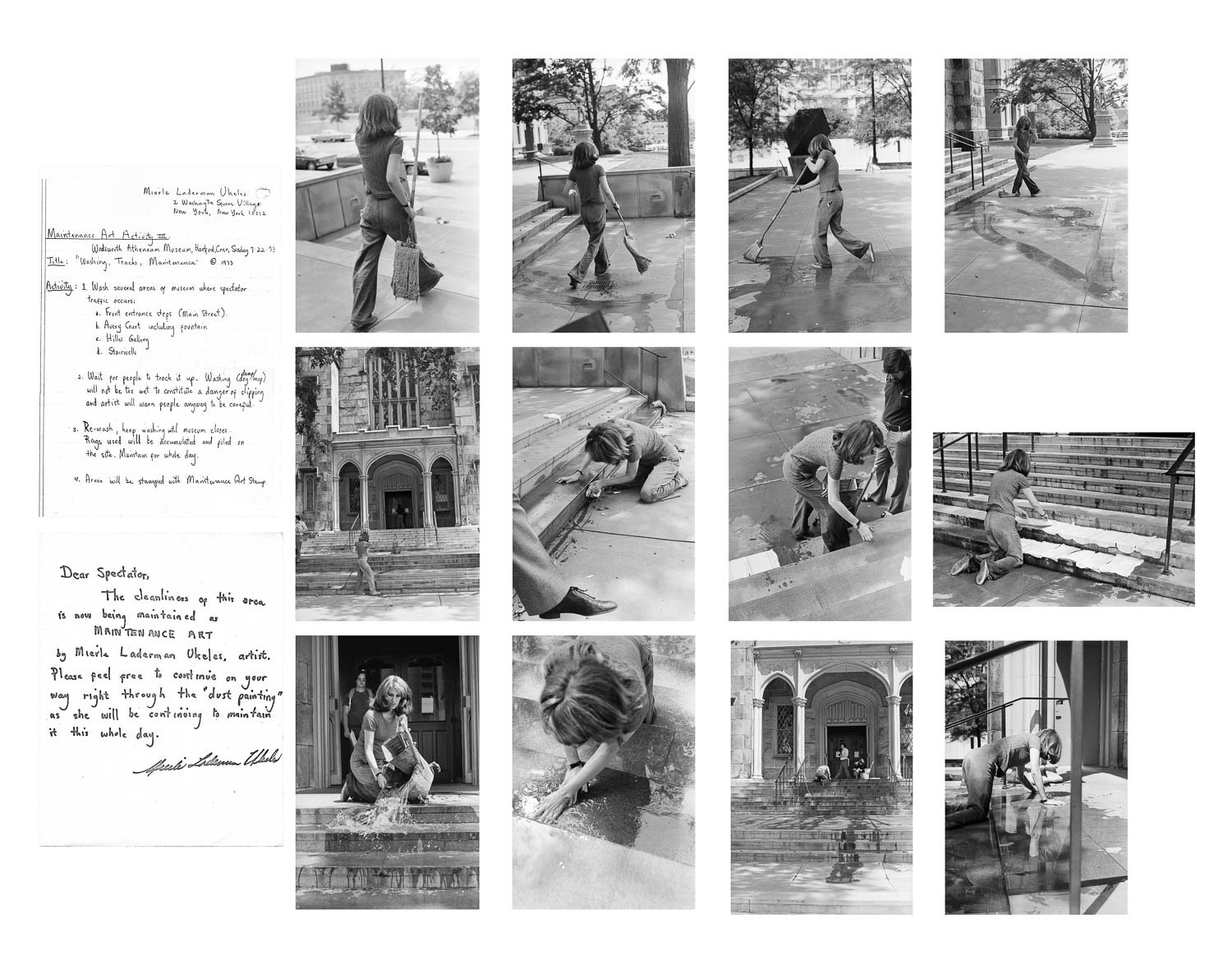The Personal is Political: The Impact of Labour
Words by Mariah Chaun
Mierle Laderman Ukeles, Washing, Tracks, Maintenance: Outside (detail), 1973
The women’s movement is a social movement which sought equal rights and opportunities for women in their economic activities, personal lives and politics. This movement is recognized as the second wave of the larger feminist movement that peaked during the 1960s and 1970s, whereas the first wave feminism focused on women’s legal rights such as the right to vote during the 19th and early 20th centuries. A variety of U.S. women’s groups, including the National Organization for Women (NOW), sought to overturn laws that enforced discrimination in matters such as contract and property rights and employment and pay. However, since the changing views of first wave feminism, a problem that these studies manifest is one that generalizes, with the tendency to write about the American woman, which race, class, region, and ethnicity have significantly divided women in twentieth-century America. This feminism is white-led and marginalizes the activism and world views of women of color. Hegemonic feminism deemphasizes or ignores a class and race analysis that focuses on an individual rights-based rather than justice-based for social change. By studying the lives of individual women during the 1920s onwards, we may begin to rediscover patterns of response to both opportunities and discrimination. Thus, once extensive research has been completed can we generalize successfully about the new women.
During the rally of the women’s movement, ‘the personal is political’ suggests that the subjective experience is not only structured by existing political arrangements, but by the effects and structures those arrangements create. Feminist theory has sought to understand the way systemic or pervasive political and cultural structures are reproduced through individual acts and practices and how the analysis of personal situations and experiences is clarified through situating the issues in a shared cultural context. The personal has been hidden against political challenge to the extent that public and private spheres endure. Therefore, the personal is political in the fact that it is dependent on shared social structures.
Mierle Laderman Ukeles, MANIFESTO FOR MAINTENANCE ART, 1969!
Proposal for an exhibition: “CARE”, 1969
Mierle Laderman Ukeles wrote a Manifesto for Maintenance Art and embarked on a career that involves mixed maintenance performances and public art. Through the Maintenance Manifesto she attempted to question and break down the barriers between the idea of work and what can be labelled artwork. Thus, blurring distinctions between work and art, to do publicly what women often do privately and to highlight how housekeeping and maintenance are essential acts in a domestic and urban context. Therefore, bringing the private to the public sphere, making what is invisible visible.
In her piece, Hartford Wash: Washing Tracks, Maintenance Inside/Outside (1973), Ukeles’ started with buckets of water and cleaning supplies, washing the staircase at the Wadsworth Atheneum museum’s entrance in Hartford, Connecticut. Later that afternoon, she moved inside, using rags to scrub the marble floors on her hands and knees, buffing away visitors’ footprints as they walked by. The entire process was carried out over eight hours, corresponding to the typical span of a work day. Ukeles’ performances made the invisible labor of maintaining the museum typically completed by low-paid workers away from the public eye, unavoidably visible. By simply scrubbing, she dramatizes the difficult but little credited work of keeping the museum clean.
Mierle Laderman Ukeles, detail of Washing, Tracks, Maintenance: Outside (July 23, 1973)
Through her performances, she brings debates around feminism, labor and value directly into the institution and public. Ukeles’ maintenance art performances involved Ukeles’ work to “flush up to consciousness” where the maintenance activities that normally absorbed so much of her time as a woman, wife, and mother. Such as washing, cleaning and cooking; by performing them within an exhibition space as “public Art activities,” her “working will be the work.” Thus, transforming the activities of the museum’s custodial and security staff into an artwork, pushing back against the perception that the work of artmaking is inherently more interesting or valuable than the work involved in maintaining it. Therefore, establishing a link between the rally of ‘the personal is political’ and those exploring institutional critique; challenging the idea that the museum is simply a neutral container for universally-recognized masterpieces.
Mierle Laderman Ukeles, Washing, Tracks, Maintenance: Inside (1973)
Mierle Laderman Ukeles, Washing, Tracks, Maintenance: Outside (1973)
Ukeles' work showcases a world where maintenance labor is equal in value to artistic labor; a proposition that targets a different organization of the public and private spheres. The significance of the category female for early feminists was not biological but political, it was then believed, for feminism’s power, it was the power of women as a group. Thus, the works of Ukeles both educates viewers about the invisible labor of women and communicates that the personal is political.
Mierle Laderman Ukeles, I Make Maintenance Art One Hour Every Day (1976)









